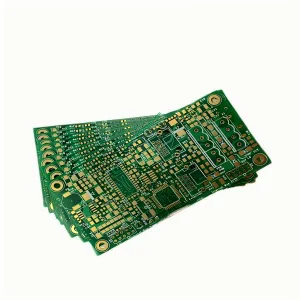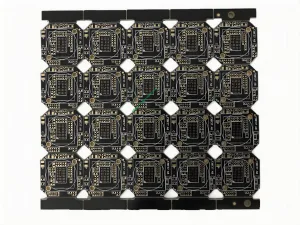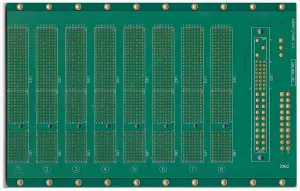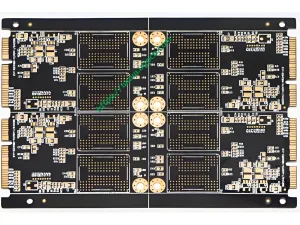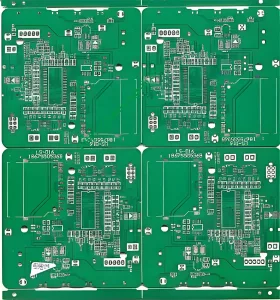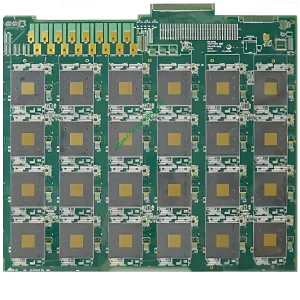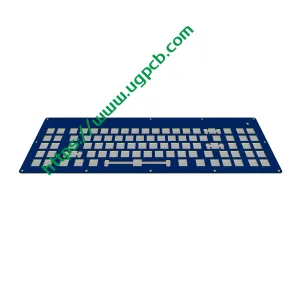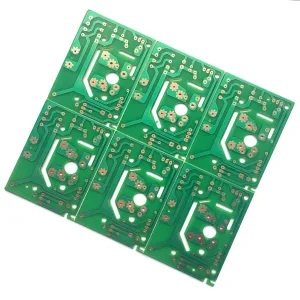2 Слоиная пласка с медной покрытием с обеих сторон, включая верхнюю и снизу. Это самая распространенная и распространенная плата PCB. Обе стороны его изоляционного субстрата имеют проводящую графику, и электрические соединения с обеих сторон в основном подключены через VIAS или прокладки. Потому что обе стороны можно подключить, Сложность проводки значительно уменьшена, так что это широко используется.
Есть проводка с обеих сторон 2 слой печатной платы, но использовать провода с обеих сторон, Должно быть соответствующее соединение схемы между двумя слоями. Этот “мост” Между целями называется пилотная дыра. Переверенное отверстие представляет собой небольшое отверстие или покрытое металлом на плате печатной платы, который может быть связан с проводами с обеих сторон. Потому что площадь двухсторонней платы в два раза больше, чем у одной панели, Двухсторонняя доска решает сложность ошеломленной проводки на одной панели (он может быть подключен к другой стороне через отверстия), и это больше подходит для более сложных цепей, чем одна панель.
Разница между 2 слой печатной платы против 4 Пчела слоя при обработке SMT
2 слой печатной платы
По сравнению с 4 СЛОВАЯ ПЕЧАТА ПЕЧАТА, Двусторонняя плата печатных плат легче использовать из-за его простого дизайна. Хотя не так просто, как одна панель, Они максимально просты, не жертвуя двусторонней входной функцией. Сниженная сложность приводит к той же сниженной цене, Но это означает, что это реже, чем четырехслойная плата печатной платы. Однако, Как наиболее часто используемая сходная плата в отрасли, Его значительное преимущество заключается в том, что нет задержки распространения сигнала.
4 слой печатной платы
Четырехслойная плата платы имеет большую площадь поверхности, чем двусторонняя плата печатных плат, что увеличивает возможность большей проводки. Поэтому, Они очень подходят для более сложного оборудования. Из -за их сложности, Производственные затраты будут выше, а разработка будет медленнее. Они также с большей вероятностью имеют задержку распространения или взаимное влияние, Итак, разумный дизайн очень важен.
2 Правила проектирования платы слоя – через и подушку
VIA называется сквозной дырой, который можно разделить через дыру, Слепая дыра, и похороненная дыра. В основном используется для подключения проводов в разных уровнях сети. Его нельзя использовать в качестве сварки сварки плагина. Через диаметр отверстия не контролируется во время производства.
PAD можно разделить на штифу и поверхностную соединительную прокладку. Пяжечная площадка имеет сварку, который в основном используется для компонентов сварки. Поверхностная соединительная площадка не имеет сварки и в основном используется для компонентов сварки.
Диаметр отверстия для прокладки должен контролироваться во время производства, с допуском плюс или минус 0,08 мм.
В основном играет роль электрического соединения. В реальном производстве, Это может компенсировать увеличение отверстия и закрытого ножа отверстия, уменьшить количество ножей и повысить эффективность работы, или уменьшить диафрагму из -за ограниченного расстояния между линиями линий и пространства ширины линии для удовлетворения производственных требований.
Апертура виа, как правило, небольшая, что обычно достаточно до тех пор, пока может быть достигнуто процесс изготовления пластины. Через поверхность можно покрыть чернилами для припоя или нет; Подушка не только играет роль электрической связи, но и играет роль механической фиксации. Апертура прокладки должна быть достаточно большой, чтобы пройти через булавки компонентов, в противном случае, это приведет к производственным проблемам; Кроме того, Поверхность накладки не должна иметь припоя, Потому что это повлияет на сварку. Допуск отверстий должен контролироваться как плюс или минус 0,08 мм или большой или маленький. Это приведет к свободной установке.
2 Процесс производства печатной платы.
Двусторонняя резка листов с медными платы, Одностороннее отверстие для тренировки, Один численная управляемая тренировка сквозного теста один, Один изгнает один чистка одного электролезного покрытия (Металлизация сквозного) Один полная пластинчатая гальваническая медь одна тестовая чистка с отрицательной схемой с отрицательной схемой на экране графики, затвердевание (сухая или влажная пленка, контакт, разработка) один тест, Образец первой линии обрезки набол. (Антикоррозивный никель/золото), один печатный материал (фото фильма), Один травление медь и одна олова снятие одной очистки чистящей чистки. (сухая или влажная пленка, контакт, разработка, тепло отверждение, Обычно используется фототермическое отверждение зеленого масла) – уборка, Высыхание одного маркера маркера маркера маркера печати, Обработка одной формы, уборка, и т. д.. В сушке и электрическом перерыве тест.
Контроль качества гальва -слоя на 2 Печатная плата с помощью слоя сквозной печати очень важна, Потому что разработка многослойной или многослойной платы до высокой плотности, высокая точность, и многофункция требует все более и более строгой силы связывания, единообразная тонкость, предел прочности, и удлинение медного слоя, Таким образом, контроль качества гальванизации на печеновой плате с печеной сквозной печати особенно важно.
Чтобы обеспечить единообразие и последовательность 2 слой платы PCB., Большинство процессов покрытия медного покрытия для распечатанных плат с высоким соотношением аспектов помогают высококачественные добавки, в сочетании с умеренным перемешиванием воздуха и движением катода, при относительно низких условиях плотности тока, так что область управления реакцией электрода в отверстии увеличена, и роль гальванических добавок может быть отображена. Кроме того, Движение катода очень полезно для улучшения способности глубокого покрытия решения для покрытия, Увеличьте поляризацию покрытых частей, и компенсируйте скорость образования кристаллических ядер и скорость роста кристаллов во время процесса электрокристаллизации плавающего слоя, Таким образом, получение медного слоя с высокой каплей.
Конечно, плотность тока устанавливается в соответствии с фактической областью покрытия 2 слой печатной платы. От принципа гальванизации, Значение плотности тока также должно зависеть от основной концентрации соли, температура раствора, аддитивный контент, и перемешивающая степень высокой кислотной и низкой меди электролита. Одним словом, Технологические параметры и условия покрытия медного покрытия должны строго контролироваться, чтобы гарантировать, что толщина медного слоя в отверстии соответствовала техническим стандартам.
Компания UGPCB является профессиональным производителем схемы PCB. Мы можем массово производить двухслойную печатную плату при низком уровне 2 Стоимость платы слоя, Итак, мы предоставляем дешево 2 слой печатной платы.
 ЛОГОТИП УГКПБ
ЛОГОТИП УГКПБ


